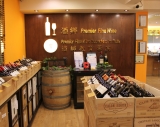Offering a unique combination of beaches, water sports and vineyards, and alive with tourist attractions, Mornington Peninsula is Victoria's answer to the Margaret River. Both regions have an extraordinary number of restaurants, many of them winery affiliated, and an abundance of accommodation in all styles. Although the wineries are relatively small, Mornington Peninsula's many different sites and mesoclimates produce an exotic array of wines.
Wine production on the Mornington Peninsula dates back to 1886, when Dromana wine won an honourable mention in the Intercontinental Exhibition in London. Five years later, 14 Peninsula grape growers were mentioned in an Australian Royal Commission into the Fruit and Vegetable Industry. In the 1920s many of the region's vineyards were abandoned or uprooted. Seppelt and Seabrook operated a vineyard in Dromana in the 1950s that was destroyed by a bushfire in 1967.
In 1972 some aspiring vignerons independently recognised the potential of the Mornington Peninsula for producing high quality, cool climate varieties. These pioneers were quickly joined by others and the region now has 200 vineyards, 60 brands and around 50 cellar doors. Viticultural and winemaking experience and a highly developed professionalism have allowed vignerons to use their terroir to produce premium quality wines which are held in high regard.
Surrounded by Bass Strait, Port Phillip Bay and Western Port Bay, the Mornington Peninsula is one of Australia’s true maritime wine regions. In this part of the world, the prevailing wind is generally either from the north and west across Port Phillip Bay or from the south and east across Bass Strait.
Situated at a latitude of around 38°, it is also classified as a cool climate region. This unique combination allows particular wine styles to flourish without many of the problems sometimes associated with a cool climate.
The maritime influence provides relatively high summer humidity, vine stress is low, sunshine hours are abundant, and rainfall is plentiful during winter and spring. The coincidence of late ripening and a prolonged gentle autumn result in fully ripe grapes with outstanding fruit flavours, high natural acidity and fine tannins.
There are four principal soil types. Hard mottled yellow duplex soils with a very distinct break marked by a thin, acid cement/sand pan between the surface soil and the underlying friable, well-drained clay are to be found in the Dromana area. Around Red Hill and Main Ridge, red soils of volcanic origin (kraznozems) predominate; these are very deep and fertile. In the Merricks area there are brown duplex soils, while much sandier soils are in evidence at Moorooduc.
Info: Australian Wine & Brandy Corporation www.wineaustralia.com












